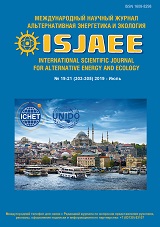 Scientific and practical peer-reviewed journal
Scientific and practical peer-reviewed journalThe international scholarly journal Alternativnaya Energetika i Ekologiya (“alternative energy and ecology”) - ISSN 1608 - 8298 is one of the world’s leading scholarly journals on issues related to alternative energy and ecology and is the organ of the International Association for Hydrogen Energy and the International Association for Alternative Energy and Ecology. The journal’s primary focus is on large-scale scientific research projects of a priority nature.
The journal is also concerned with the study of various issues related to hydrogen energy and hydrogen transportation and discussion of a wide spectrum of issues in alternative energy and ecology as a whole. In addition, the journal covers issues related to the safety of transportation systems and that of hydrogen transportation.
Readers are provided with the opportunity to delve into original, never-before-published, research studies in the area of physico-mathematical, engineering, and chemical sciences across the following groups of specialties: Physics, Kinetics and Catalysis, Ecology (engineering and chemical sciences), Aviation and Rocket and Space Technology, and Energy.
Most of these are studies conducted by members of the Russian Academy of Sciences, as well as members of other academies and leading scientists from around the world. In addition, the journal receives regular input from researchers at training institutes, universities, and research institutes across Russia.
The journal is intended for specialists in the area of physico-mathematical, engineering, and chemical sciences and is published twice a month. 4 new issues of the journal come out every two months and issues are not merged together.
The journal’s English titles are:
- International Journal of Hydrogen Energy (IJHE)
- International Scientific Journal for Alternative Energy and Ecology (ISJAEE).
- Solar Energy
The best works on energy generation published in International Scientific Journal for Alternative Energy and Ecology are also published in International Journal of Hydrogen Energy, and translated versions of the works from International Journal of Hydrogen Energy which are of interest for International Scientific Journal for Alternative Energy and Ecology are published in the latter.
International Journal of Hydrogen Energy (IJHE) (Elsevier) is issued 4 times per month and has high scientometric indices such as Global citation indices - Journal Metrics: Source Normalized Impact per Paper (SNIP): 1.424; SCImago Journal Rank (SJR): 1.338; Impact Factor: 2.930 (Thomson Reuters Journal Citation Reports 2014); 5-Year Impact Factor: 3.448 (Thomson Reuters Journal Citation Reports 2014).
All the papers published in IJHE are included in SCOPUS, and Web of Science, as well as in the following indexing systems:
Indexed/Abstracted in: Chemical Abstracts (Online), Chemical Engineering and Biotechnology Abstracts (Online), Chimica, Compendex, Currents Abstracts, Current Contents, EnCompassLit, Energy * Power Abstracts, Inspec, PubMed, Referativnyi Zhurnal, Russian Academy of Sciences Bibliographies, Science Citation Index Expanded, TEMA-Technology and Management, Web of Science, Also covered in the abstract and citation database SCOPUS.
The scope of topics presented in International Scientific Journal for Alternative Energy and Ecology is approved by the International Association for Hydrogen Energy, editorial board of International Journal of Hydrogen Energy, and UNIDO-ICHET.
Original scope of topics presented in International Scientific Journal for Alternative Energy and Ecology overlaps with the whole scope of topics presented in International Journal of Hydrogen Energy and includes issues relating to renewable power generation, non-renewable power generation, and clean generation technologies.
Editorial board of International Scientific Journal for Alternative Energy and Ecology includes renowned scientists from 25 countries of the world. Among the worldwide known members of editorial board of International Scientific Journal for Alternative Energy and Ecology, the following scientists shall be mentioned at the first turn: Vladimir Yevgenyevich Fortov, the President of the Russian Academy of Sciences (since 2005), academician Yury Alekseyevich Trutnev (since 2000), academician Anatoly Sazonovich Koroteyev (since 2003), academician Nikolai Nikolayevich Ponomarev-Stepnoi (since 2003), professor C. Marchetti (since 2008), professor Michael Douglas Hampton (since 2000), doctor Boris Petrovich Tarasov (since 2000), doctor professor Viktor Alekseyevich Goltsov (since 2000), and many others.
For its activities, International Scientific Journal for Alternative Energy and Ecology won many international scientific awards, including Monetary Award of International Association for Hydrogen Energy (IAHE): in 2000 and 2014; the Silver Medal of Roentgen (2007), Diploma of the Vernadsky Fund and the RF FA State Duma Committee on Environment (2007), award of Russian Energy Olympus (2008), and other international scientific awards.
Editorial board of International Scientific Journal for Alternative Energy and Ecology has conducted more than 10 High-Level International Scientific Forums, among which the most remarkable are IFSSEHT (2000, Russia, Sarov) and the 1st International Congress on Alternative Energy and Environment WCAEE-2006 (Volga) (2006, Russia, Sarov).
Since 2000, peer-reviewed International Scientific Journal for Alternative Energy and Ecology (ISJAEE) http://isjaee.hydrogen.ru has published scientific articles and scientific reviews in academic and applied sciences written by renowned scientists from 50 countries of the world, which confirms the high scientific level and topicality of the journal.
Since 2000 International Scientific Journal for Alternative Energy and Ecology (ISJAEE) ISSN 1608-8298 has played as the most important channel of relevant information exchange between the East (the Russian-speaking community) and the West (the English-speaking community).
Impact Factor of Russian Science Citation Index (2014) together the translated version is 0,577. Two-year Impact Factor of Russian Science
Citation Index (2014) - 0,555. h-index for 10 years - 10. Herfindahl index of the authors’ organizations – 261.
The journal is registered in UNESCO in ISSN International Centre in 2000 (key title: “Al’ternativnaâ ènergetika i ècologiâ”, abbreviated key
title: “Al’tern. ènerg. ècol.”), ISSN 1608-8298. The subjects of the journal are approved by International Association for Hydrogen Energy (IAHE).
The journal has been included into the “List of leading reviewed scientific journals and editions in which the basic scientific results of dissertations
on competition of scientific degrees of Doctors and Candidate of Sciences (Ph.D. and Sc.D.) should be published” according to the decision of
Presidium of the Higher Certifying Commission.
The journal has been included into catalogues: “Rospechat’” (20487), Joined catalogue “Press of Russia. Russian and foreign newspapers and
journals” (41935), “Interpochta-2003”.
Journal awards: Röntgen Medal (2007), Award of V. I. Vernadskyi fund and RF State Committee for Ecology (2007). The Premium “Russian
Energetic Olympus – 2008”.
The journal has been included into the abstract journal and data base VINITI. Information on the journal is annually published in the international
reverence system of periodical of current issues “Ulrich’s Periodicals Directory”.
Full version of papers has been presented at Scientific electronic library http://e-library.ru, web-site of International Scientific Journal for Alternative
Energy and Ecology http://isjaee.hydrogen.ru, and International Information and Education Portal “Hydrogen” http://www.hydrogen.ru.
The journal has been registered at Russian Federal Service on Supervision of Observance of the Legislation in Sphere of Mass Communications and Protection of a Cultural Heritage (Certificate PI No FC77-21881) September 14, 2005.
Position of ISJAEE in SCIENCE INDEX rating for 2012 – 9740; in General Rating for 2012 – 291; on the topic “Environmental Protection. Human Ecology” – 7; on the topic “Energy” – 1
Translated version of International Journal of Hydrogen Energy is included into Scopus and Web of Science as well as international databases.
Current issue
I. RENEWABLE ENERGY. 5. Energy of biomass. 5-3-0-0 Energy of biomass and ecology
II. NON-RENEWABLE ENERGY. 9. Atomic energy. 9-1-0-0 Atomic-hydrogen energy
II. NONRENEWABLE ENERGY. 9. Atomic energy. 9-4-0-0 Personnel preparation for atomic energy
IV. HYDROGEN ECONOMY 12. Hydrogen economy. 12-5-12-0 Novel hydrogen production methods
IV. HYDROGEN ECONOMY. 12. Hydrogen economy. 12-5-0-0 Hydrogen production methods. 12-5-7-0 High-temperature process for hydrogen production
XV. ENERGY SAVING. 35. Energy-Saving Technologies, Systems, Materials, and Instruments
XX. НАУКИ О ЗЕМЛЕ
XXII. ИНФОРМАЦИЯ В ОБЛАСТИ АЭЭ. 41 Информация 41-7-0-0 Рекламные материалы научных организаций, инвестиционных фирм и фирм-производителей
XXII. INFORMATION IN THE FIELD OF ENERGY EFFICIENCY. 41. Information. 41-16-0-0 News
Announcements
2025-07-09
001- Мероприятия Международной Ассоциации Альтернативной Энергетики и Экологии: First Mediterranean Conference on Alternative Energy and Ecology - I MCAEE-2025 ((17-19, September, 2025)
First Mediterranean Conference on Alternative Energy and Ecology - I MCAEE-2025 (September 24-26, 2025)

| More Announcements... |
































